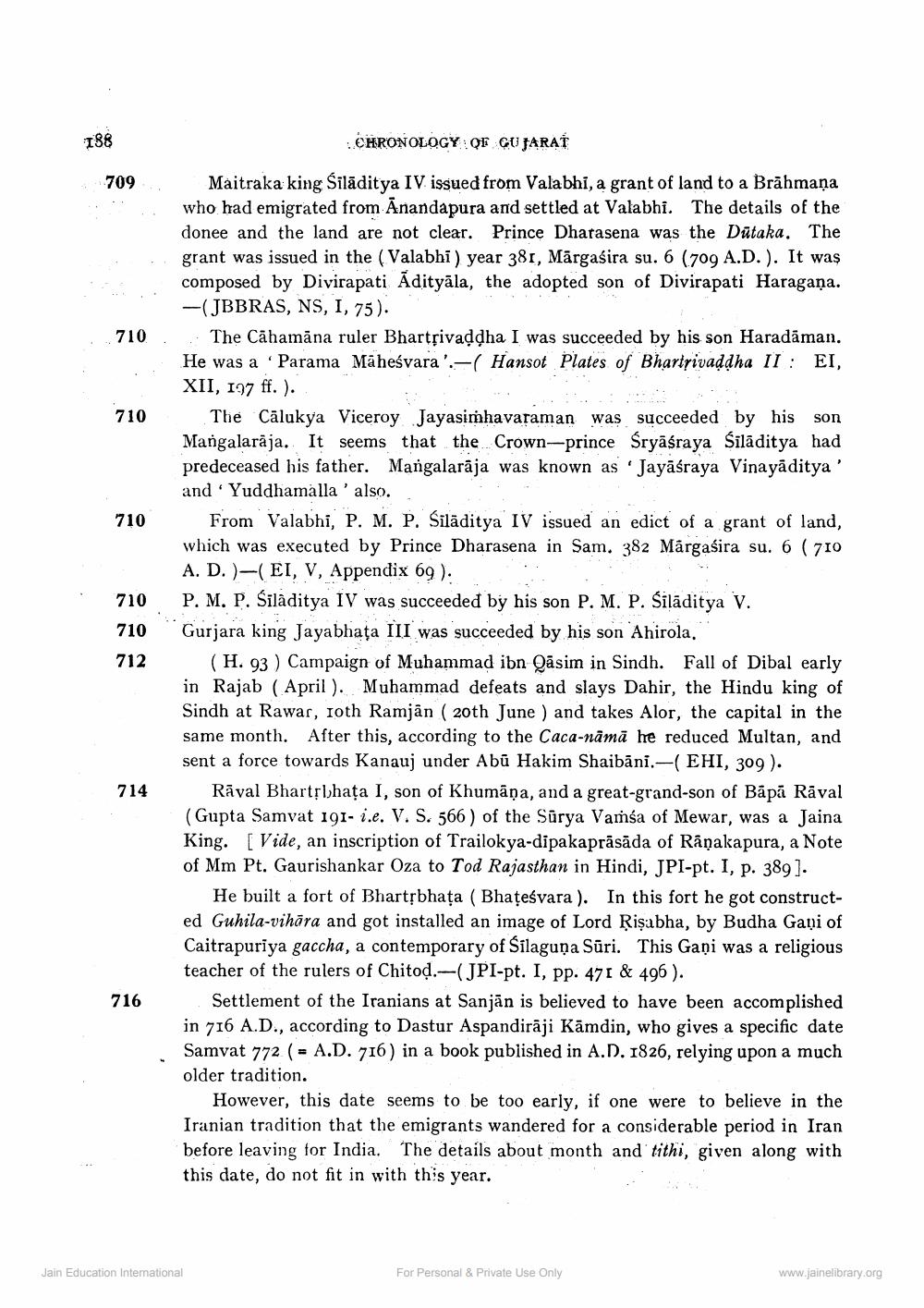________________
188
CHRONOLOGY QE GUJARAT
709
710
710
710
710 710 712
Maitraka king Silāditya IV issued from Valabhi, a grant of land to a Brāhmaṇa who had emigrated from Anandapura and settled at Valabhi. The details of the donee and the land are not clear. Prince Dharasena was the Dütaka. The grant was issued in the (Valabhi) year 381, Märgasira su. 6 (709 A.D.). It was composed by Divirapati Adityāla, the adopted son of Divirapati Haragaña. - (JBBRAS, NS, I, 75).
The Cāhamāna ruler Bhartsivaddha I was succeeded by his son Haradāman. He was a 'Parama Māheśvara'.-( Hansot Plates of Bharirivaddha II : EI, XII, 197 ff.).
The Cālukya Viceroy Jayasimhavaraman was succeeded by his son Mangalarāja. It seems that the Crown-prince Sryāśraya Silāditya had predeceased his father. Mangalarāja was known as Jayāśraya Vinayāditya' and Yuddhamalla 'also.
From Valabhi, P. M. P. Siladitya IV issued an edict of a grant of land, which was executed by Prince Dharasena in Sam. 382 Märgasira su. 6 ( 710 A. D. )-(EI, V, Appendix 69 ). . P. M. P. Siladitya IV was succeeded by his son P. M. P. Silāditya V. Gurjara king Jayabhața III was succeeded by his son Ahirola.
(H. 93 ) Campaign of Muhammad ibn Qasim in Sindh. Fall of Dibal early in Rajab (April). Muhammad defeats and slays Dahir, the Hindu king of Sindh at Rawar, roth Ramjân ( 20th June ) and takes Alor, the capital in the same month. After this, according to the Caca-nāmā he reduced Multan, and sent a force towards Kanauj under Abū Hakim Shaibāni.—( EHI, 309 ).
Rāyal Bhartrlhata I, son of Khumāna, and a great-grand-son of Bāpā Rāval (Gupta Samvat 191- i.e. V. S. 566 ) of the Sürya Vamsa of Mewar, was a Jaina King. [Vide, an inscription of Trailokya-dipakaprāsāda of Rânakapura, a Note of Mm Pt. Gaurishankar Oza to Tod Rajasthan in Hindi, JPI-pt. I, p. 389].
He built a fort of Bhartsbhața (Bhateśvara). In this fort he got constructed Guhila-vihāra and got installed an image of Lord Rişabha, by Budha Gați of Caitrapuriya gaccha, a contemporary of Silaguna Sūri. This Gani was a religious teacher of the rulers of Chitod.-(JPI-pt. I, pp. 471 & 496 ).
Settlement of the Iranians at Sanjān is believed to have been accomplished in 716 A.D., according to Dastur Aspandirāji Kāmdin, who gives a specific date Samvat 772 ( = A.D. 716) in a book published in A.D. 1826, relying upon a much older tradition.
However, this date seems to be too early, if one were to believe in the Iranian tradition that the emigrants wandered for a considerable period in Iran before leaving for India. The details about month and tithi, given along with this date, do not fit in with this year.
714
Jain Education Intemational
For Personal & Private Use Only
www.jainelibrary.org




